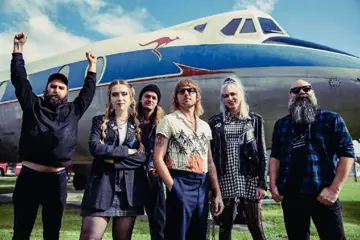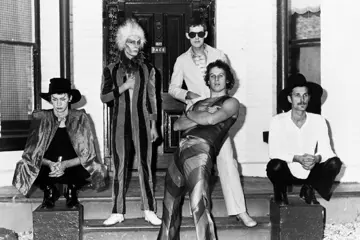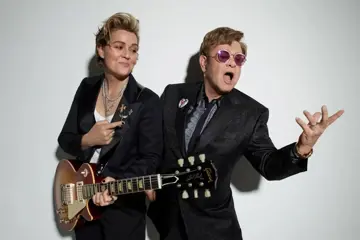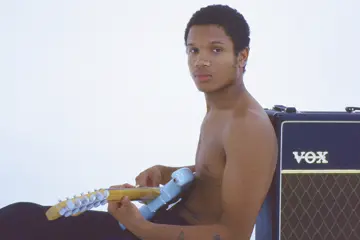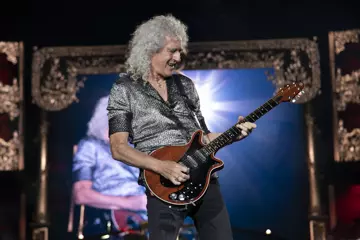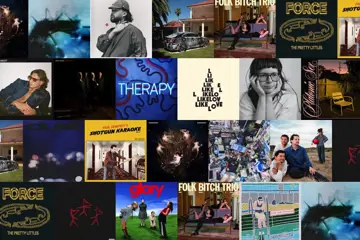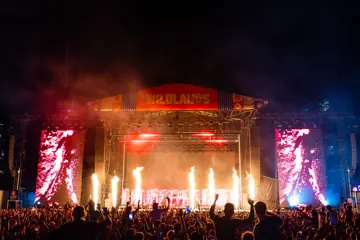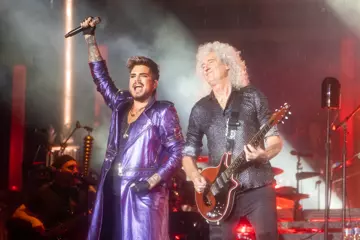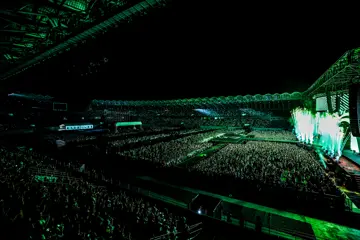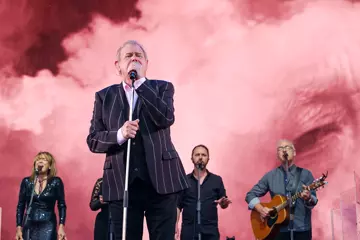 Sonic Youth
Sonic YouthMurray Street is in stores now.
Over the last two decades, arguably no one has stretched the possibilities of guitar rock further than Sonic Youth.
With a monumental sound that marries the freedoms of improvisation with the orchestral possibilities of guitar feedback, the fury of punk rock and a haunting, melancholic take on pop melody, Sonic Youth are mavericks that have also captured the imagination of legions of music appreciators.
Their determined pursuit of open-ended music can be maddening to some, but Sonic Youth have always rewarded close attention. New album Murray Street (their sixteenth!) finds the group at their most accessible in years, with some of the warmest guitar textures since Daydream Nation and Thurston Moore’s vocals regularly taking on board a Neil Young-esque higher register. It’s a yearning, almost romantic record, but also challenging, edgy and powerful, its feet planted equally in the avant-garde and the rock/pop camps.
Over the phone, guitarist Lee Ranaldo is filling me in on the group’s recent activities.
“We did a festival called All Tomorrow’s Parties in the States,” he says. “We also had Television along and Eddie Vedder, Wilco, Papa M, The Boredoms, Big Star, Steve Malkmus, Cecil Taylor. There was a spoken word evening as well.”
Named after the location of Sonic Youth’s studio in New York City, Murray Street was an album surrounded by monumental world events. The band started recording in August 2001. Then, on September 11, the planes hit the Twin Towers nearby, and the group had to understandably postpone proceedings. When they returned, there was a layer of dust everywhere, including on the band’s instruments and master tapes, but no major damage. Incidentally, the band’s latest recruit Jim O’Rourke was sleeping in the studio when the planes hit.
Don't miss a beat with our FREE daily newsletter
“It was mostly just weird,” says Lee of recording in such an intense environment. “We had hassles getting back into the studio, because we had to prove we belonged in the building. We were set back about three months.”
Did the emotions of September 11 sneak into Murray Street?
“It’s not something we tried to force,” Lee responds. “All the material was already written when September 11 happened. When we resumed work, aspects of the events filtered into the music, but there is nothing specific or referential to September 11. So I would shy away from giving the impression that parts of the album directly respond to that day.”
Murray Street, according to the group’s latest press release, is the second album in a proposed trilogy about the cultural history of Lower Manhattan (which began with 2000’s NYC Ghosts & Flowers).
“That was sort of a mind-game by the guy that wrote our bio,” explains Lee. “There’s a lot of material about New York on this record, but to call it the second part of a trilogy is a bit of stretch. Maybe it will come to pass that peoples’ perceptions will place it as part of a trilogy, but it’s not something we’re deliberately doing.”
One notable aspect of Murray Street is that it is the first Sonic Youth album to feature prolific experimental musician and uber-producer Jim O’Rourke as a fully- fledged member, although he had already provided his production services to NYC Ghosts & Flowers.
“Jim’s just a really good friend. We’d been hanging out with him more and more,” says Lee. “It was great that he put aside time to work with us. He had a big hand in this record production-wise.”
So is Jim a permanent fixture of Sonic Youth?
“I hope so. It certainly feels that way,” says Lee. “It was very casual the way it worked out. We weren’t consciously looking for a fifth member. When Jim joined, it wasn’t a stretch, or even a transition, it just seemed completely normal and natural!”
With Jim on board, Sonic Youth’s improvisational spirit remains as strong as ever. To this day, the band’s music comes from spontaneity.
“Our songs are never really pre-conceived at all,” says Lee. “It’s just a matter of us playing and the songs come out of where the music is taking us. We don’t conceptualise anything when we get together. We like to think our songs are open-ended and we pretty much let that take over.”
For all members of Sonic Youth, the pursuit of different projects is a major part of their lives. Aside from musical diversions, members are involved in visual arts and even literature. As Lee puts it, “We’re all at our happiest when we’re working.”
And whenever Sonic Youth reconvene for a new recording project, Lee says being involved with a major label doesn’t hinder their work.
“We’re very lucky, the label has pretty much left us alone. We don’t turn in demos for them to listen to. We’re not being dropped for failing to deliver commercially viable material or whatever.”
This is despite the fact that Sonic Youth’s avant-garde tendencies are at odds with the bottom line priorities of the recording industry.
“I don’t know what it is,” says Lee. “I think it’s like we’re bringing some level of prestige or something to the label. But we get our creative freedom and we also run our own label SYR, which is another outlet to put out stuff we like.”
Looking back on a career that has included such groundbreaking rock albums as Daydream Nation, Sister and Goo, surely there’s an element of pride about Sonic Youth’s achievements.
“Oh yeah, I mean how could we not feel proud?” says Lee. “I know that our music has meant a lot to many different people.”
With hopes for Sonic Youth to return to Australia in February or March of next year, Lee is aware that much of the band’s loyal following is located on these very shores. Murray Street should win even more hearts.


